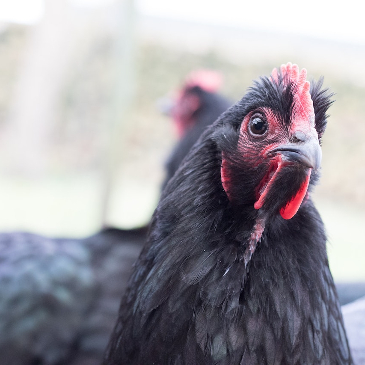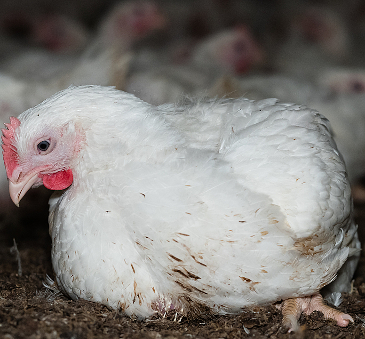It’s a shockingly big number which is very difficult to believe so here’s some authoritative sources to back it up …
- According to ‘AnimalClock.Org’ in the US alone over 8 BILLION chickens are killed annually.
- ‘OurWorldinData.org’ reports that worldwide over 202 MILLION chickens are killed every single day
- Rooster Haus Rescue states that 1 MILLION chickens are killed every hour in the US.
I could go on.
Yes, “The Colonel” has a lot to answer for. We seem to have become hopelessly addicted to eating chicken meat. In 2021 we got through about 140 million tons of the stuff [1]. That’s a lot of birds but how many chickens are killed a day? How many individual souls lose their lives in a 24 hour period? Well … we have the stats below and it’s clucking shocking.
How Many Chickens Are Killed a Day?
Visualise: roughly 205 million chickens are killed in a day. That’s every single day, 365 days a year. I actually don’t think it’s possible to truly get your head around that number. It equates to 143 thousand chickens killed every minute of the day, worldwide. If that doesn’t shock you then I don’t know what will.
Watch: The grim reality of how millions of chickens are ‘processed’ daily.
( Trigger warning : this video will definitely distress you unless you lack an empathy gland )
Related: Do Chickens Feel Sad When Another Chicken Dies?
A Brief History Of Chicken Production
The days are long gone when chickens would scurry around a nice big coop with plenty of space to roam and perch. In the wild, chickens cover quite large distances and are social animals naturally forming strong bonds with each other.

Chickens also develop a very definite hierarchy within their flock. The dominant chicken will have priority access to resources like water, food and nesting spots.
The lower ranked chickens will often be harassed and bullied by the dominant chicken. This can cause significant stress and anxiety for the subordinate birds.
In fact, this is where the term “pecking order” comes from. Studies of domesticated chickens in the 1920’s revealed that higher ranking birds peck lower ranking birds and this is how individuals understand their place in the flock.
Fast forward to today and chickens are usually raised in large, crowded factory farms where they have almost no space to move around or express their natural behaviours. This can lead to a number of health problems for the population, including feather loss, cannibalism, and stress.
In a factory farm setting, chickens are unable to form their social bonds, which causes even more stress and anxiety. With their natural instincts so completely repressed they resort to attacking each other in a desperate attempt to deal with the situation they find themselves in.
The Fast And The Furious
Demand for chicken meat has exploded since the end of the second world war and this has driven the massive growth in factory farming operations.
 In the 1950’s here in the UK a chicken dinner was considered a luxury. Now we feast on buckets of chicken wings where it may have taken the lives of ten birds to provide a single meal.
In the 1950’s here in the UK a chicken dinner was considered a luxury. Now we feast on buckets of chicken wings where it may have taken the lives of ten birds to provide a single meal.
To a vegan this is an absolutely gross abuse of our standing in the animal kingdom ‘pecking order’. Yet the human race continues on its destructive path without batting an eyelid.
We have become so detached from where our food actually comes from. Cheap supermarket deals and glitzy advertising of fast food draws us in … it seems we simply don’t care about the dystopian conditions the birds are raised in.
In the UK we consume 25 times as much chicken as we did in the 1950’s [2] and in the US it’s a similar figure. This mushrooming demand has driven the industry to produce birds that grow unnaturally quickly, causing all sorts of health issues.
Slaughter Numbers: Off The Scale
The majority of chickens raised for meat (broiler chickens) live out their brief, desperate lives in vast sheds housing 40 thousand birds or more.

These sheds are often unsanitary and overcrowded, which leads to debilitating conditions of lameness and widespread disease.
They are also fed a diet that is high in growth hormones and antibiotics. In recent years, antibiotic resistance has emerged as yet another threat to bird and human health.
After just 5-6 weeks, when they have reached their slaughter weight, the chickens are transported to a slaughterhouse and killed.
… and we humans kill them in eye-watering numbers.
In 2021 the combined poultry production of the US, Europe, China and Brazil was around 83 million tonnes [1].
When you look at individual birds slaughtered it is a number so big that most of us simply cannot imagine the scale of the global operation …
Approximately 75 billion birds are killed every year, equating to 205 million chickens killed every single day. Take a look at the stats below:
Graph showing the number of animals slaughtered annually for meat:
I don’t think we really need to say much more than that. The numbers speak for themselves.
Part Of The Problem Or The Solution?
Chickens have had a really rough trot in the last few decades. As the health concerns around red meat become more well known, chicken meat has been seen as a suitable alternative.
 As we can see in the stats above, demand has simply exploded. It is this demand which drives the farming ‘efficiencies’ and why we’re currently bearing witness to one of the biggest crimes against nature ever perpetrated by humans.
As we can see in the stats above, demand has simply exploded. It is this demand which drives the farming ‘efficiencies’ and why we’re currently bearing witness to one of the biggest crimes against nature ever perpetrated by humans.
Veganism addresses this crime and approaches the problem from a place of compassion.
If you don’t eat chicken or eggs you’re not responsible for creating the demand which condemns these birds to the short, miserable lives they currently endure.
It’s a very simple concept but has profound outcomes for the human race …
… mainly survival.
Because one thing is for sure, if we carry on down this path of dystopian hell, abusing nature and pursuing profit above all else, it will turn around and bite us in the backside.
… and guess what? That’s already starting to happen with the climate crisis gaining pace.
Is it time for you to make the decision to be part of the solution?
Is it time for you to be vegan?
I hope this article has helped answer your question and clarified the issue for you today. I would love to hear your thoughts, so please leave a comment below – I always respond. Please also share this article with others, using the social buttons.
Lastly, if you’d like to be alerted when we post new content here at Vegan Slate, please sign up to our post notifications and you’ll be the first to know.
Thanks so much for reading and have a peaceful day.
Rohan.
Broiler chicken image: Benjamin Blomstedt / We Animals Media
[1] Hannah Ritchie, Pablo Rosado and Max Roser (2017) – “Meat and Dairy Production”. Published online at OurWorldInData.org. Retrieved from: ‘https://ourworldindata.org/meat-production’ [Online Resource] – Data source: http://www.fao.org/faostat/en/#data/QCL [2] Compassion In World Farming. Farm Animals →Chickens Farmed For Meat. Published at ciwf.org.uk – Retrieved from https://www.ciwf.org.uk/farm-animals/chickens/meat-chickens/ on 18th July 2023.